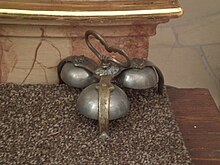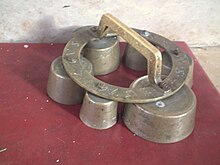Altar bell
A produced mostly in forging altar bell (also "measuring bell", "Altar clamp ", "Sanktus bell ", latin tintinnabulum or campanula ; French clochette ; English altar bell or Sanctus bell is one of) altar servers by pivoting or turning by hand geläutetes liturgical instrument , which is used at certain points during the celebration of mass (e.g. during the conversion ) in order to accentuate the particularly holy moment acoustically and thus draw the attention of the faithful to the liturgical events at the altar. During Holy Week , ratchets or wooden rattles are used instead of the altar bells .
Description and history
The altar bells, probably only known since the 13th century, usually consist of four (but it can also be two, three, five or six) small bells and a cross or ring-shaped holder with a common handle. In rare cases the handle was replaced by a cross or the (three) bells were once again encased by a common sound body. The bells of an altar bell can be different or the same size; the interplay of different bells results in a wider or fuller sound spectrum.
symbolism
The four-part altar bells refer to Christ's work of redemption through their cross shape; three-part, however, refer to the Trinity of God ( Trinity ).
Beliefs
Altar bells originated in the area of the Roman Catholic Church ; however, they are also used regionally during the Lutheran and Anglican mass celebrations. They are not known in the Orthodox churches .
See also
literature
- Matthew D. Herrera: Sanctus bells: History and Use in the Catholic Church. Tixlini Scriptorium, San Luis Obispo 2004, ISBN 0-9723720-3-2 . ( Digitized version )
Web links
- Altar bells, history and use (RDK article)
- Bells or bells ringing during the change (English)


